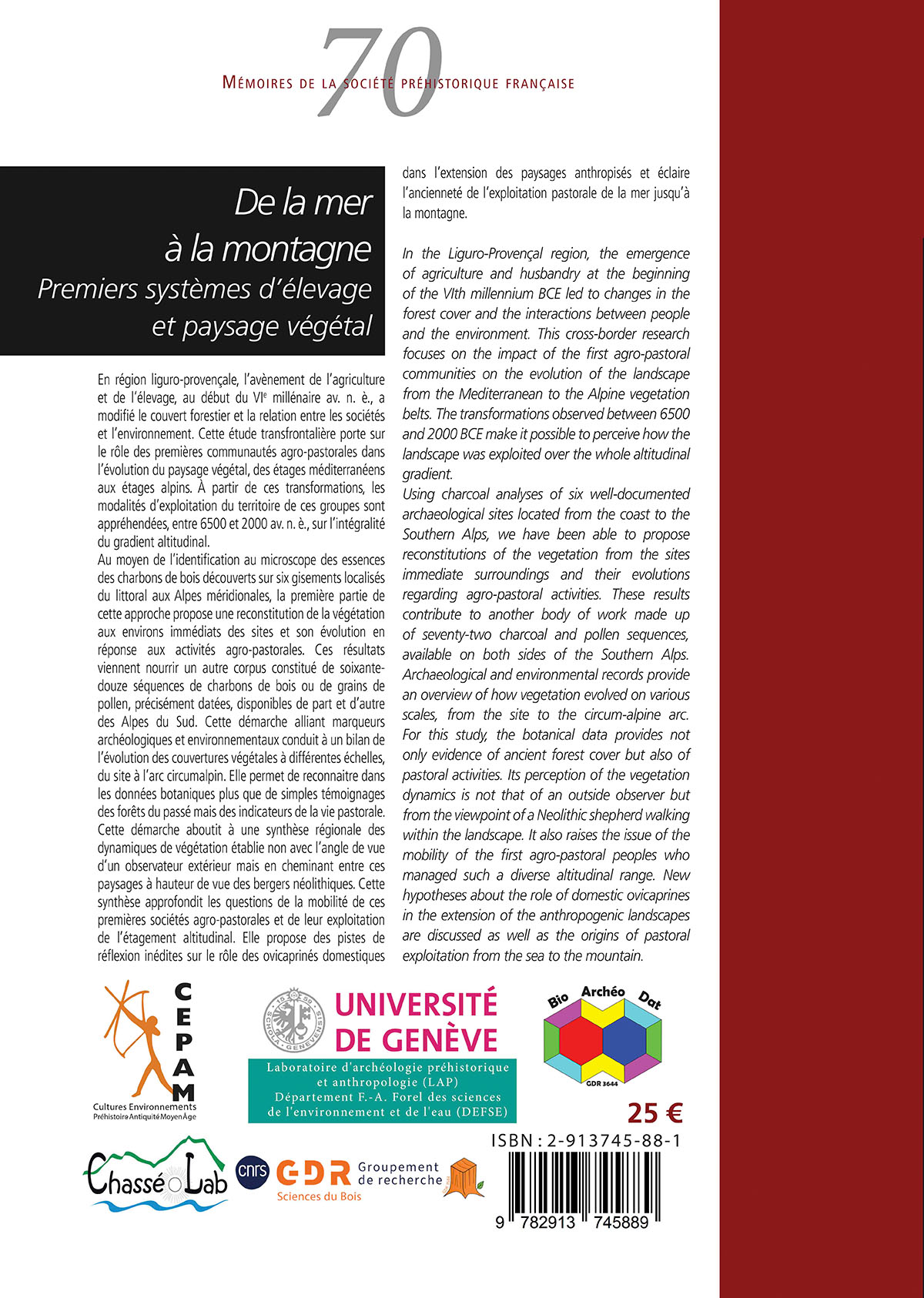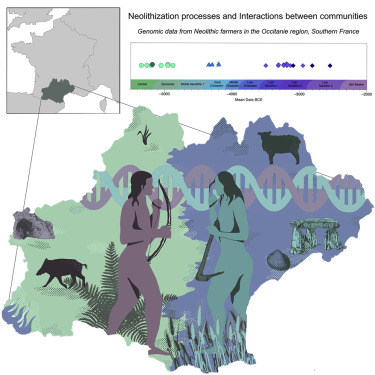
Source : https://www.inee.cnrs.fr/fr/cnrsinfo/dirait-le-sud-rencontres-entre-groupes-neolithiques-et-chasseurs-cueilleurs-en-occitanie
Article : https://doi.org/10.1016/j.isci.2022.105387
Archaeological research shows that the dispersal of the Neolithic took a more complex turn when reaching western Europe, painting a contrasted picture of interactions between autochthonous hunter-gatherers (HGs) and incoming farmers. In order to clarify the mode, the intensity, and the regional variability of biological exchanges implied in these processes, we report new palaeogenomic data from Occitanie, a key region in Southern France. Genomic data from 28 individuals originating from six sites spanning from c. 5,500 to c. 2,500 BCE allow us to characterize regional patterns of ancestries throughout the Neolithic period. Results highlight major differences between the Mediterranean and Continental Neolithic expansion routes regarding both migration and interaction processes. High proportions of HG ancestry in both Early and Late Neolithic groups in Southern France support multiple pulses of inter-group gene flow throughout time and space and confirm the need for regional studies to address the complexity of the processes involved.
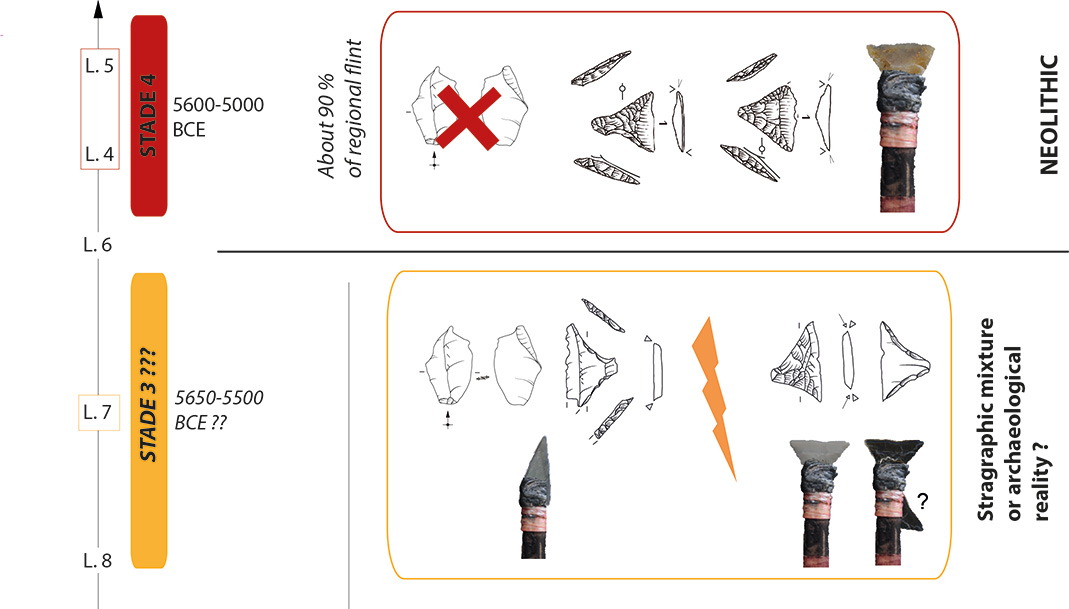
Source : https://doi.org/10.1515/opar-2022-0261
Abstract: The use of weapons, and therefore of arrowheads, contributed to structuring the technical, economic, social and cultural domains. In the technical sphere, emblematic projectile armatures are often considered to be loaded with cultural values and to embody the expression of human group identity. The study of their variability, in time and space, can shed light on mechanisms of mutation and innovation stemming from adaptative strategies and cultural choices.
During the seventh and sixth millennia, the renewal of arrowheads corresponds to major changes in lithic equipment. Between the Late Mesolithic and the Early Neolithic, we observe a diversification of arrowhead shapes and the evolution of represented types. These observations enhance interpretative scenarios, especially questions concerning the transfer of know-how, techno-economic renewal and neolithization. This paper proposes to study these changes at the sequence of the Baume de Montclus site, a key site in Southern France. The selected sequence covers 1.5 millennia of occupation, roughly from 6500 to 5000 BCE cal., with a corpus of geometric bitruncations of about 650 pieces. The combined study of microwear and technological and typological data leads to a comprehensive interpretation of manufacturing processes, hafting methods and function. These analyses provide valuable information on the diversity of arrowheads, the identification of specific technical traditions and the characterization of techno-functional ruptures throughout this sequence. These results will subsequently be integrated in a wider, regional and extra-regional context, with a particular focus on the emergence of blade and trapeze complexes and the neolithization of the western Mediterranean basin.
Key-word: Arrowheads, use-wear analyses, typo-technological study, technical traditions, neolithization.
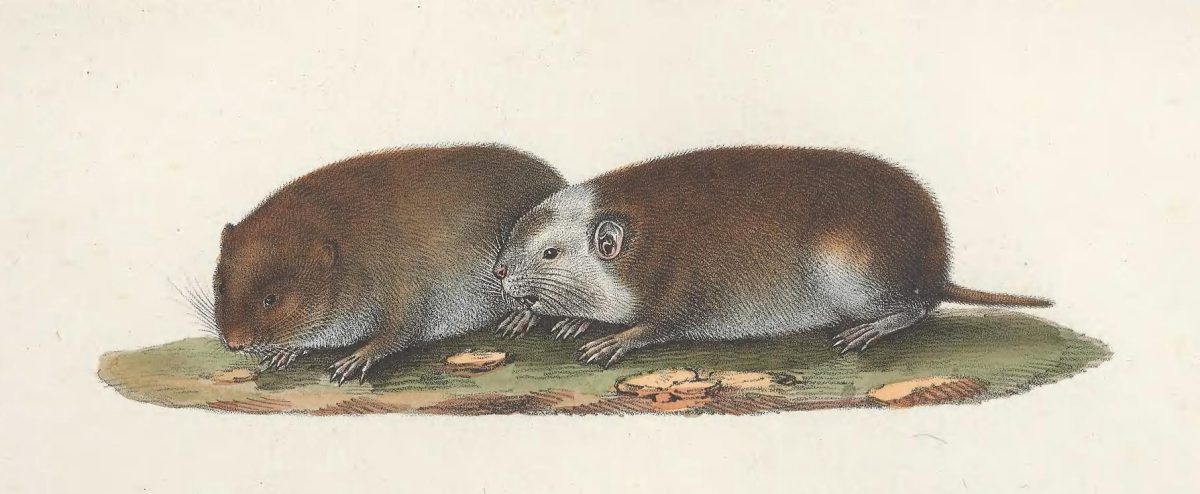
Many species experienced population turnover and local extinction during the Late Pleistocene. In the case of megafauna, it remains challenging to disentangle climate change and the activities of Palaeolithic hunter-gatherers as the main cause. In contrast, the impact of humans on rodent populations is likely to be negligible. This study investigated which climatic and/or environmental factors affect the population dynamics of the common vole (Microtus arvalis). This temperate rodent is widespread across Europe and was one of the most abundant small mammal species throughout the Late Pleistocene. A dataset comprised of 4.2 kb long fragment of mitochondrial DNA (mtDNA) from 148 ancient and 51 modern specimens sampled from multiple localities across Europe and covering the last 60 thousand years (ka) allowed to reconstruct – by using We used Bayesian inference – their phylogenetic relationships and to estimate the age of the specimens that were not directly dated. The time to the most recent common ancestor of all last glacial and extant common vole lineages was estimated to be 90 ka ago and the divergence of the main mtDNA lineages present in extant populations to between 55 and 40 ka ago, which is earlier than most previous estimates. Several lineage turnovers were detected in Europe during the period of high climate variability at the end of Marine Isotope Stage 3 (MIS 3; 57–29 ka ago) in addition to those found previously around the Pleistocene/Holocene transition. In contrast, data from the Western Carpathians suggest continuity throughout the Last Glacial Maximum (LGM) even at high latitudes. The main factor affecting the common vole populations during the last glacial period was the decrease in open habitat during the interstadials, whereas climate deterioration during the LGM had little impact on population dynamics. This suggests that the rapid environmental change rather than other factors was the major force shaping the histories of the Late Pleistocene faunas.
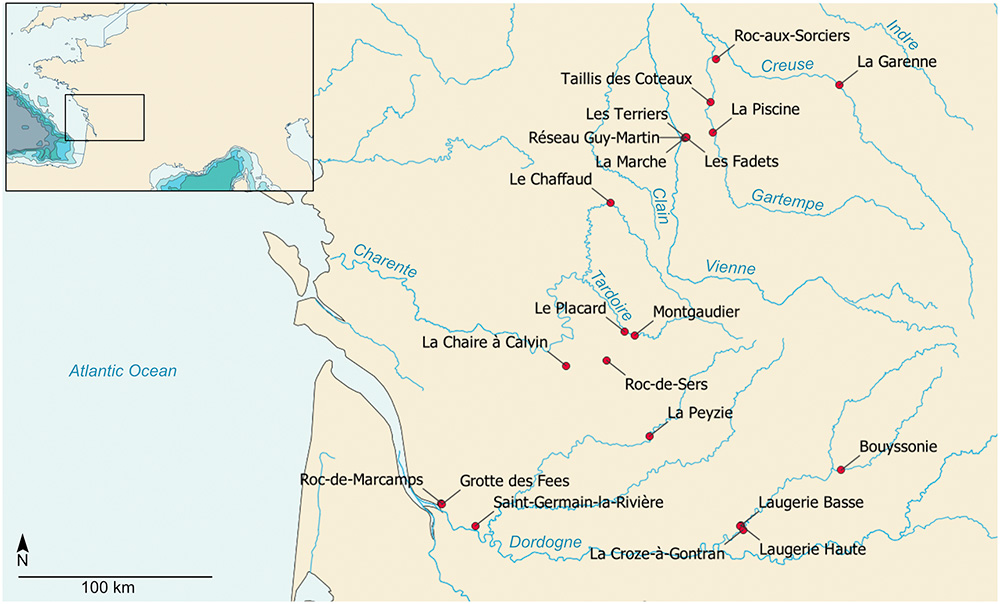
Source : https://doi.org/10.1371/journal.pone.0274819
The beginning of the Middle Magdalenian is marked by an increase in the density and geographic extension of evidences of human occupation across western Europe. The Early Middle Magdalenian (19,5–17,5 ka cal. BP) thereby extends from Poland to Spain, and the sharing of the flint-knapping concepts and the circulation of raw materials show the existence of networks active over this wide area. In parallel, part of the production of art, ornaments, microliths, bone industry, and the proportions of hunted ungulates vary regionally and allow to identify distinct technical traditions. Departing from a palethnographic approach at a regional scale, this paper aims at participating in renewing our understanding of the mechanisms of regionalisation during the period, and among past societies of hunter-gatherers. The reflection is based on the techno-functional analysis of stone tools from two cave sites of west-central France that are at the heart of the definition of two technical traditions: La Marche (Magdalenian with Lussac-Angles points) and the Blanchard cave (Magdalenian with navettes). Inter-site comparisons of the functioning and management of stone tools, and of subsistence strategies show the sharing of techno-economical norms, expressing the adhesion to a wider community of practice. The long-term occupation of at least part of the caves and the high density of sites in the Vienne, the Creuse, the Gartempe, and the Charente Valleys, indicate the strong regional implantation of human societies. This strong territoriality (effective and symbolic) is likely a major factor to understand the specificity of the EMM expressions in the area, as well as the sharing, in the same economic territory, of technical norms and of part of the system of symbolic representation.
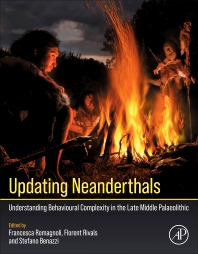
Source : https://www.elsevier.com/books/updating-neanderthals/romagnoli/978-0-12-821428-2
Ethel Allué ; Carolina Mallol; Vera Aldeias, Aitor Burguet-Coca, Dan Cabanes, Ángel. Carrancho, Rory Connolly, Lucia Leierer, Susan Mentzer, Christopher Miller, Dennis. Sandgathe, Mareike Stahlschmidt, Isabelle Théry-Parisot, Manuel Vaquero (2022). Fire Among Neanderthals. In: Francesca Romagnoli, Florent Rivals, Stefano Benazzi (Eds.) “Updating the Neanderthals: understanding behavioural complexity in the late Middle Palaeolithic”. Elsevier, pp 227-242.
Description de l’ouvrage :
Updating Neanderthals: Understanding Behavioral Complexity in the Late Middle Paleolithic provides comprehensive knowledge on Neanderthals who lived throughout the European and Asian continents. The book synthesizes historical information about the study of Middle Paleolithic populations and presents current debates about their genetics, subsistence, technology, social and cognitive behaviors. It focuses on the last phase of Neanderthal settlements and presents the main patterns of modern humans across Europe. Written by international experts on the Middle Paleolithic who have conducted innovative studies in the last three decades, this book explores the implications of interactions between different human species, including Neanderthals, Denisovans and Sapiens. In addition, the book discusses the diversity and variability of human adaptations and behaviors in the changing climate and environment of the Late Pleistocene, and the relationship between these behaviors, demography and cognitive capabilities.
les prochaines journées du GDR https://sciencesdubois.sciencesconf.org/
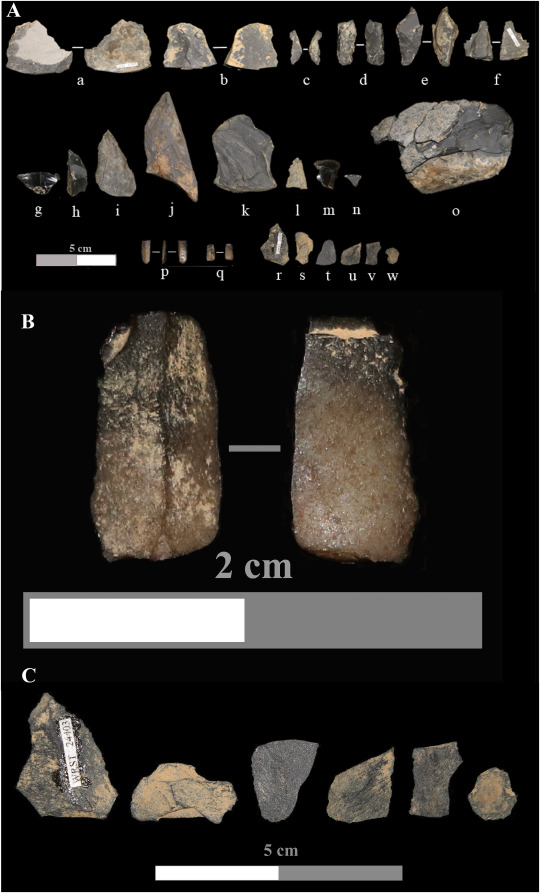
Source : https://doi.org/10.1016/j.quaint.2022.08.012
After decades of debate, the homeland of the First Americans is now generally understood to be northeast Asia; however, the process of Late Pleistocene peopling remains unresolved. As more archaeological sites south of the continental ice sheets are discovered that predate the opening of the interior “ice-free” corridor, interest in a coastal Pacific dispersal route has grown, and previously overlooked regions proximal to the Pacific coast have become a central focus of exploration efforts. The Copper River basin of southern Alaska is one such region. Here we present the results of 2019 archaeological excavations at Nataeł Na’, a buried and stratified archaeological site situated along the upper Copper River. The site contains a robust occupation dating to the late Younger Dryas climate reversal as well as an earlier occupation dating to the late Allerød interstadial. This discovery demonstrates that Pleistocene hunter-gatherers inhabited the Pacific basin of southern Alaska during the same time Clovis peoples inhabited temperate North America. The occupations at Nataeł Na’ join a growing body of evidence suggesting that the early inhabitants of eastern Beringia were geographically more widely dispersed than previously documented.
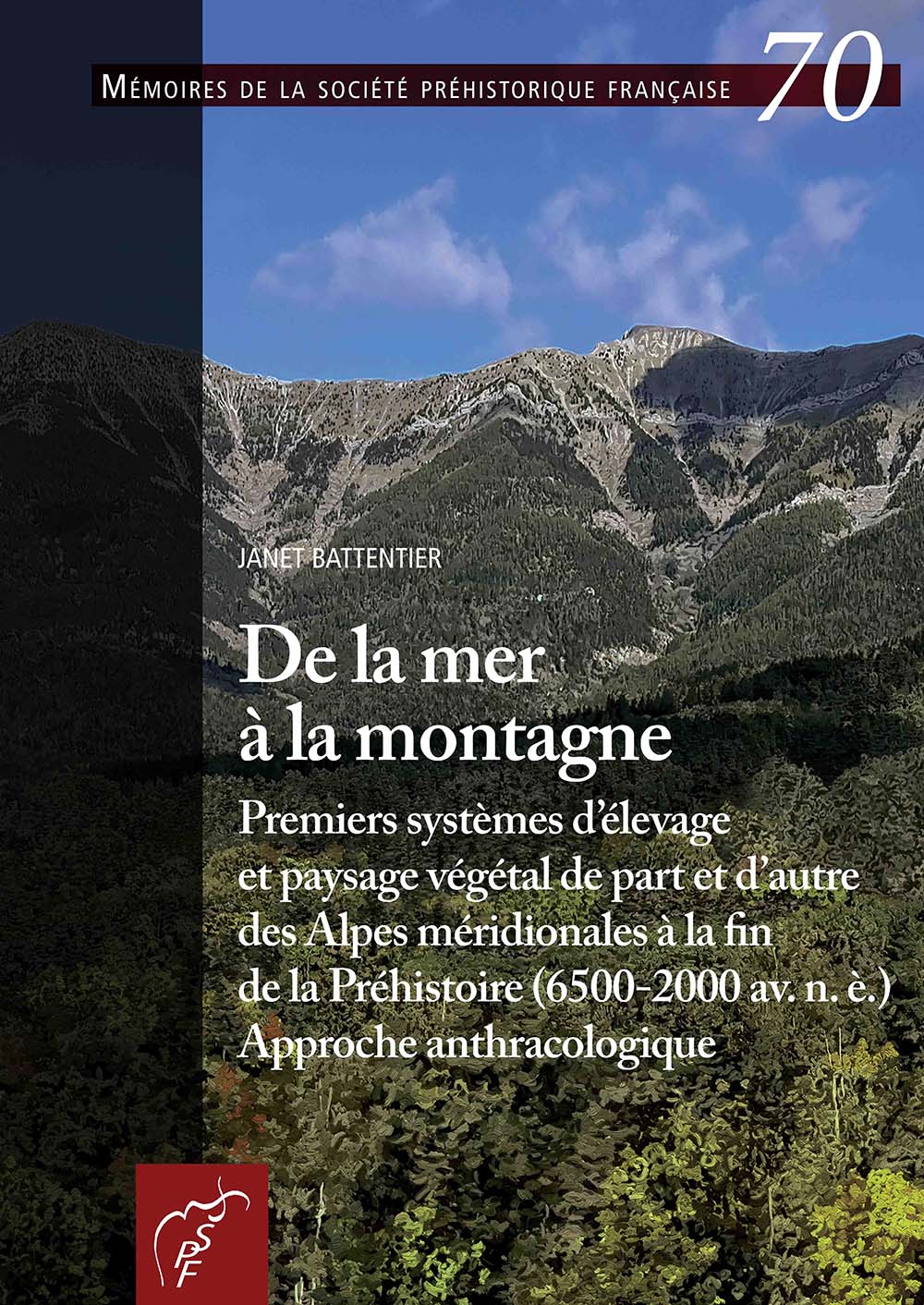
Cet ouvrage tiré du doctorat de Janet Battentier, réalisé au CEPAM, vient de paraître dans le n°70 des Mémoires de la Société Préhistorique Française. Il a été publié avec le soutien financier du laboratoire CEPAM, du Laboratoire d’Archéologie Préhistorique et Anthropologie de l’Université de Genève, du groupement de recherche 3644 « BioarchéoDat », du groupement de recherche 3766 « ChasséoLab » et du groupement de recherche 3544 « Sciences du Bois ».
En région liguro-provençale, l’avènement de l’agriculture et de l’élevage (début du VIe millénaire BCE) a modifié le couvert forestier et la relation entre les sociétés et le milieu qu’elles exploitent. L’analyse anthracologique de six sites archéologiques répartis du littoral jusqu’à 1000 m d’altitude et occupés entre la fin du Mésolithique (Castelnovien) et le Néolithique final (ca 6500-2000 BCE) précisent les modalités de ces évolutions, venant combler les lacunes chronologiques, géographiques et sitologiques d’un large corpus préexistant (78 séquences, anthracologiques et polliniques, en contexte archéologique ou naturel).De part et d’autre de l’arc liguro-provençal, des dynamiques de végétation relativement similaires se traduisent de façon variable en termes de paysages. Au Castelnovien et à l’Impressa (6500-5600/5400 BCE), les futaies denses et diversifiées prédominent sur un large gradient altitudinal. Dans les basses terres et en altitude, les milieux ouverts, sans doute plus propices aux activités de subsistance (chasse, pastoralisme, agriculture) semblent toutefoispréférés par les derniers mésolithiques et les premiers néolithiques.A partir de la seconde moitié du VIe millénaire BCE, de la méditerranée aux étages alpins, les premières atteintes anthropiques sur le couvert forestier favorisent l’augmentation discrètedes végétaux tolérant l’ouverture du milieu et le recul des taxons plus sensibles. Bien que ce processus se renforce progressivement, à toutes les altitudes, sur fond de diversification de l’exploitation du territoire, des séquences anthracologiques attestent du maintien des chênaies caducifoliées dans l’arrière-pays jusqu’au Néolithique final. Ainsi, au fil du Néolithique, l’ouverture anthropique du milieu se déploie sous forme d’éclaircies, de plus en plus répandues mais qui demeurent localisées. Le recul des formations forestières, la baisse de leur diversité et l’essor des taxons de milieux ouverts témoignent directement d’un changement des paysages débuté sans doute en amont, par la modification de l’apparence des forêts (taillis vs futaies). Ainsi, le paysage végétal actuel trouve sa genèse dans les pratiques néolithiques.
Mots-clés : Néolithique, paysage, anthracologie, dynamique de végétation, pastoralisme, Holocène, Méditerranée nord-occidentale.
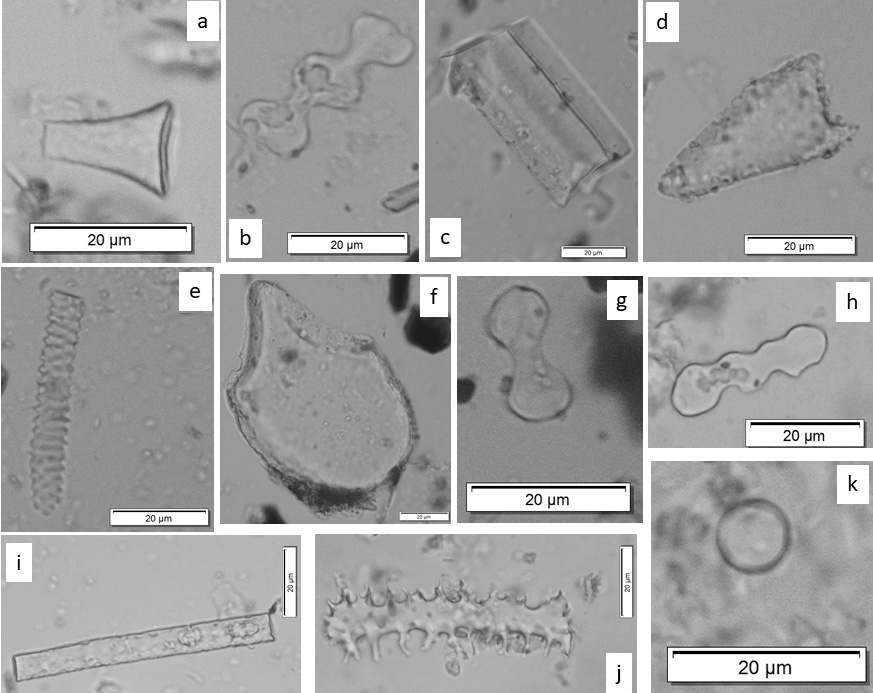
Source : https://doi.org/10.3390/biology11081102 & https://www.ncbi.nlm.nih.gov/pmc/articles/PMC9331568/
HAL : https://hal.archives-ouvertes.fr/view/index/docid/3768217
Abstract :
The present paper aims to present the newsworthy results and interpretation of the interdisciplinary analysis conducted at an Early Chalcolithic settlement (Isaiia, Romania). The archaeological campaigns of 2015 and 2017 offered remarkable results including a ceramic vessel, inside which an anthropomorphic figurine (with pregnancy depiction) and a small cone, both made out of clay, were found. Given the special character of the deposition, we collected several samples from the vessel and near it for phytolith analysis; samples of bone found next to the pot and from the nearby features were also dated by AMS radiocarbon. The palaeobotanical evidence based on the phytolith analysis showed that cereals and probably mugwort seem to have been in association with the small artefacts; both, and especially the latter, are known, aside from their practical uses (as aliment or remedy), as powerful symbols, used through the ages in magic practices. All of these facts nuance and augment the cultic interpretation of the deposition as a result of a ritual related to fertility (possibly to counteract some physiological problems or reproductive disorders) involving both feminine and masculine symbols and the use of plants.
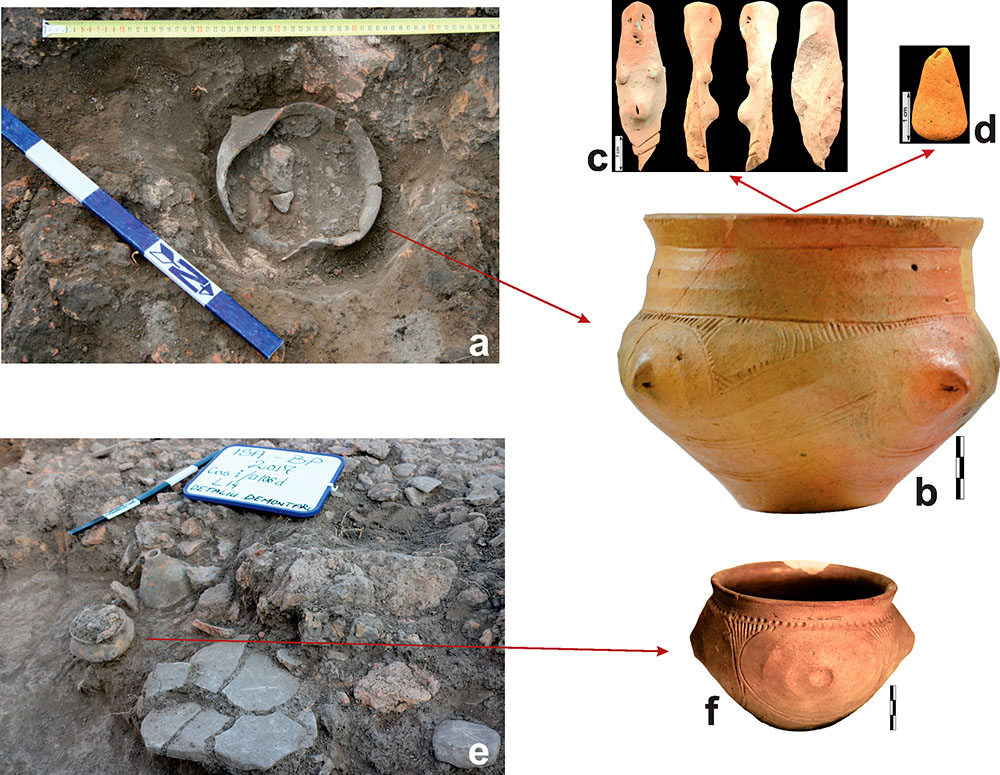
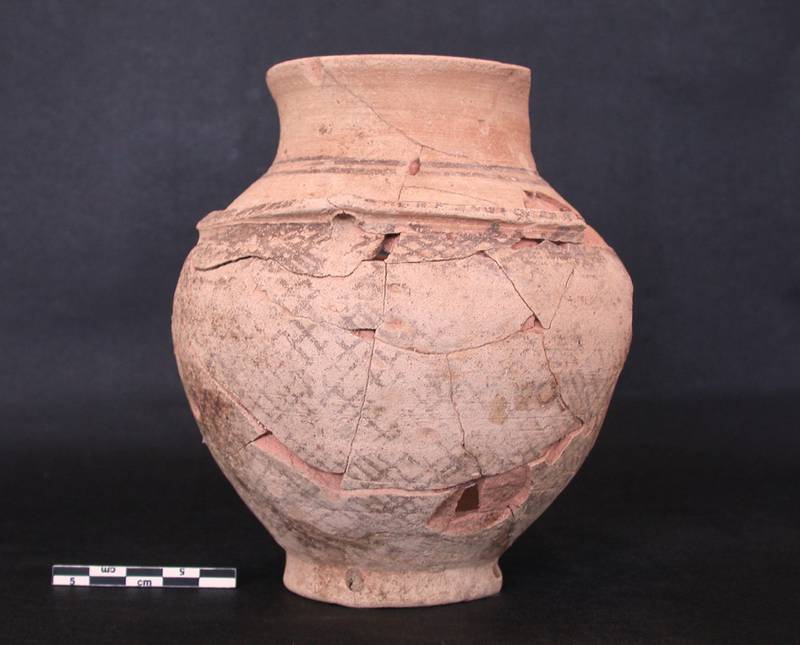
Source : https://www.thenationalnews.com/uae/heritage/2022/08/27/fat-and-oil-residues-from-thousands-of-years-ago-shed-new-light-on-the-uaes-past/
Lien HAL : https://hal.archives-ouvertes.fr/hal-03759054
Abstract : Exchange networks in the Bronze Age between SE Arabia, Mesopotamia, SE Iran, SW Pakistan and the Indus Valley moved a variety of raw and finished products, especially pottery. However, we have little understanding of what organic products were a part of these exchange networks, as well as what foodstuffs were prepared in ceramic vessels as part of everyday activities. This paper presents the preliminary results of lipid residue analysis of local and imported vessels from Hili 8 and Hili North Tomb A in al-Ain, United Arab Emirates (UAE). Absorbed lipids were extracted and analysed via Gas Chromatography-Mass Spectrometry (GC-MS) from a range of vessels, including local, regional, Indus, Mesopotamian and Makran wares. A majority of the lipid profiles were indicative of degraded animal fats, however some vessels, including Fine Red Omani Ware and imported Black-Slipped Jars from the Indus Valley, had evidence for plant oils. Further analyses that will shed light on the possible origin of the animal fats and plant oils are ongoing. The preliminary results provide new insights into the use of pottery at Hili, with broader implications for our understanding of subsistence and exchange networks in the region.
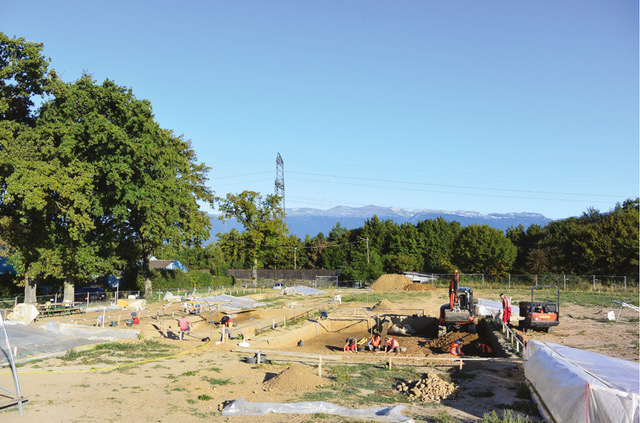
Besse M., Piguet M., Steimer-Herbet T., Isabelle André, Anouk Bystritzsky-Papilloud, Antony Carbone, Julie Debard, Benjamin Gehres,Michel Guélat, Auréade Henry, Tobias Hofstetter, Emmanuel Mens. 2022. 4500 ans d’occupation au Pré-du-Stand (Grand-Saconnex – Genève). Annuaire d’archéologie Suisse 105 : 7-46.
https://archaeologie-schweiz.ch/fr/annuaire-archeologie-suisse/
Henry A., Piguet M., Steimer-Herbet T., Besse M. (2021). Foyers empierrés du Bronze final : nouvelles données anthracologiques issues des structures de combustion du Pré-du-Stand (Grand-Saconnex, Genève, Suisse). ArchéoSciences 45 (2) : 7-29.
https://journals.openedition.org/archeosciences/10320
Besse M., Piguet M., Carbone A., Henry A., Girardclos S., Debard J., Hofstetter T., Bystritzsky-Papilloud A., Steimer-Herbet T. (2021). Funerals During the Second Iron age: A Newly Discovered Sepulchral Ensemble Reveals Practices in Western Switzerland (Pré-Du-Stand, Geneva). Journal of Anthropological & Archeological Sciences 4 (5). DOI: 10.32474/JAAS.2021.04.000198
https://archive-ouverte.unige.ch/unige:153804









